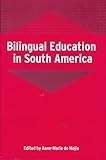Bilingual Education in South America / Anne-Marie de Mejía.
Material type: TextSeries: Bilingual Education & BilingualismPublisher: Bristol ; Blue Ridge Summit : Multilingual Matters, [2005]Copyright date: ©2005Description: 1 online resource (152 p.)Content type:
TextSeries: Bilingual Education & BilingualismPublisher: Bristol ; Blue Ridge Summit : Multilingual Matters, [2005]Copyright date: ©2005Description: 1 online resource (152 p.)Content type: - 9781853598197
- 9781853598203
- 370.117/098 22
- LC3735.S68 B55 2005eb
- online - DeGruyter
| Item type | Current library | Call number | URL | Status | Notes | Barcode | |
|---|---|---|---|---|---|---|---|
 eBook
eBook
|
Biblioteca "Angelicum" Pont. Univ. S.Tommaso d'Aquino Nuvola online | online - DeGruyter (Browse shelf(Opens below)) | Online access | Not for loan (Accesso limitato) | Accesso per gli utenti autorizzati / Access for authorized users | (dgr)9781853598203 |
Frontmatter -- Contents -- Introduction -- Language Policy and Local Planning in South America: New Directions for Enrichment Bilingual Education in the Andes -- Rethinking Bilingual Education in Peru: Intercultural Politics, State Policy and Indigenous Rights -- Bilingual Deaf Education in the South of Brazil -- Bilingual Education in Colombia: Towards an Integrated Perspective -- The Evolution of Bilingual Schools in Argentina -- English Immersion in Paraguay: Individual and Sociocultural Dimensions of Language Learning and Use -- A Look at Early Childhood Writing in English and Spanish in a Bilingual School in Ecuador -- EFL and Native Spanish in Elite Bilingual Schools in Colombia: A First Look at Bilingual Adolescent Frog Stories
restricted access online access with authorization star
http://purl.org/coar/access_right/c_16ec
The development of bilingual education in South America can be traced back to the arrival of the Spanish and Portuguese colonisers in the 15th and 16th centuries, when Catholic missionaries began their evangelisation of the indigenous peoples using local vernaculars, as well as Latin, Spanish and Portuguese. Traditionally, debate on bilingual education has been conducted in two separate arenas: majority language contexts involving international languages, such as English, French, Spanish and Portuguese, and minority community contexts aimed at maintaining native Amerindian languages as well as the different Sign Languages of the South American Deaf communities. This book presents an integrated vision of bilingual education in six South American nations: three Andean countries, Peru, Ecuador, and Colombia, and three ‘Southern Cone’ countries, Brazil, Argentina and Paraguay. It includes work carried out in minority as well as majority language contexts, referring to developments in the fields of indigenous, Deaf, and international bilingual and multilingual provision.
Mode of access: Internet via World Wide Web.
In English.
Description based on online resource; title from PDF title page (publisher's Web site, viewed 01. Dez 2022)


